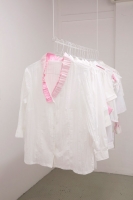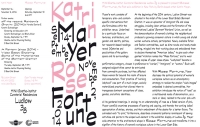Rose Fortune
Ludlow 38, MINI/Goethe-Institut, New York
13. September - 2. November 2014
http://www.ludlow38.org/
curated by Eva Birkenstock
.
.
scroll down for images...
.
.
Mayer's work consists of temporary site- and content-specific interventions that she formulates within the exhibition venue. Underlined by a particular focus on textures, architecture, and gender and identity politics, her research-based readings reveal (hi)stories and peculiarities of the gallery space and its surroundings.
At the beginning of the 20th century, Ludlow Street was situated in the midst of the Lower East Side's Garment District. It was an epicenter of immigrant life and class struggles, including labor strikes and the formation of the International Ladies' Garment Workers' Union, as well as the democratization of women's clothing: the neighborhood produced a growing consumer culture in which young and stylish women workers actively participated. Newly available fiction and fashion commodities, such as dime novels and ready-made clothing, mingled into their working days and emboldened them to declare themselves "American ladies," to give each other genteel Victorian names like "Rose Fortune," and to wear cheap copies of upper class styles. "Ladyhood" became a performative category, chosen in preference to "worker," "immigrant," or "woman." Such self-assigned subjectivities cannot be extricated from commodity purchase, but they affected these women far beyond the realm of leisure and consumerism. Their practice of "working ladyhood" was part of a much larger, socially materialized practice that allowed them to transgress dominant conceptions of class, gender, and ethnic identities.
With Rose Fortune, Mayer discloses the political potential of women's workplace culture as an emancipatory strategy to realize the utopian "wish-images" embedded in desired commodities. Her exhibition introduces the notion of "rose" as a multilayered mode of denomination, as a mark or label, related to the color pink with all its gendered meanings. In analogy to an understanding of rose as a faded version of pink, Mayer carefully examines processes of layering and copying, and thereby the working ladies' appropriation of styles, stories, and their embodiment of the desire for a better future. The outmoded verb "to pink," furthermore, describes ornamental patterns reminiscent of sewing activities and points to the sloped wall element in the exhibition display at Ludlow 38. Mayer calls attention to this architectural shape in Rose Fortune and transforms it into a signifier of the history of women's workplace culture in the Lower East Side.
.
.
Material:
industrial tissue paper for sewing (pink)
wrapping tissue paper / Seidenpapier (white)
pink neon tube
40 blouses from thrift shops, wire hangers, 2 acrylic tubes, white cord
pink spray paint
print outs b/w, needles
.
.
Further Events:
- off the record: Rainbow’s Gravity (2014) by Mareike Bernien & Kerstin Schroedinger
Screening and subsequent discussion with Kerstin Schroedinger and Shelly Silver
- A Pattern (since 2014) - Video Essay Exploring Some of the Materialities of the Garment District
Screening and conversation between Emma Hedditch and Katrin Mayer
.
Tell me about your fortune, Rose
Text über die Ausstellung von von Isabel Mehl:
http://kubaparis.com/tell-me-about-your-fortune-rose/
.
Interns Ludlow38: Leah Heckel and Pia Goebel
Photos: Marc Tatti
.



























